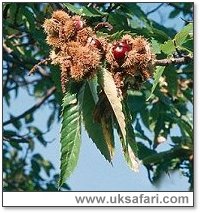
|

|
|
 Sent
to you Sent
to you
by e-mail
|
|
Simply
enter your details and hit the send button
more
info |
|


Click Here

Links
Advertise
Terms of Use
Contributors
About Us
Contact Us
|
 |
Go back
 | Bookmark
| Bookmark
 | Print Page
| Print Page  | E-Mail Us
| E-Mail Us 
 

Photo: G. Bradley |
|
UK
Safari Tip:
To help you identify different trees get the colourful fold out chart
called "Tree Name Trail" from the Nature Shop - click
here
|
|
Latin name: Castanea sativa
Size: Grows to around 30m high.
Distribution: Found throughout the UK, less common in Scotland.
Flowering months: June to July
Special features: The sweet chestnut is a native tree of Anatolia (Asia Minor), which was probably introduced to Britain by the Romans.
The bark of the tree is fairly smooth when young, but as the tree ages and grows, it splits into wide spiralling grooves. It's large lower branches hang downwards. The dark green, glossy leaves
(See Picture) grow to about 30cms long.
In early summer the tree is covered with long yellow catkins. At the base of each catkin is the female flower which develops into the shiny brown chestnut.
The nut is encased in a prickly, leathery casing which opens in autumn, allowing the nuts to fall. They don't stay on the ground for long, as the squirrels collect them for their winter food store.
Did You Know?
The nuts of the sweet chestnut are edible, in fact the Romans fed their legions on sweet chestnut porridge.

UK Safari Tree Section
UK Safari Plants and Trees Section
|
 |

|